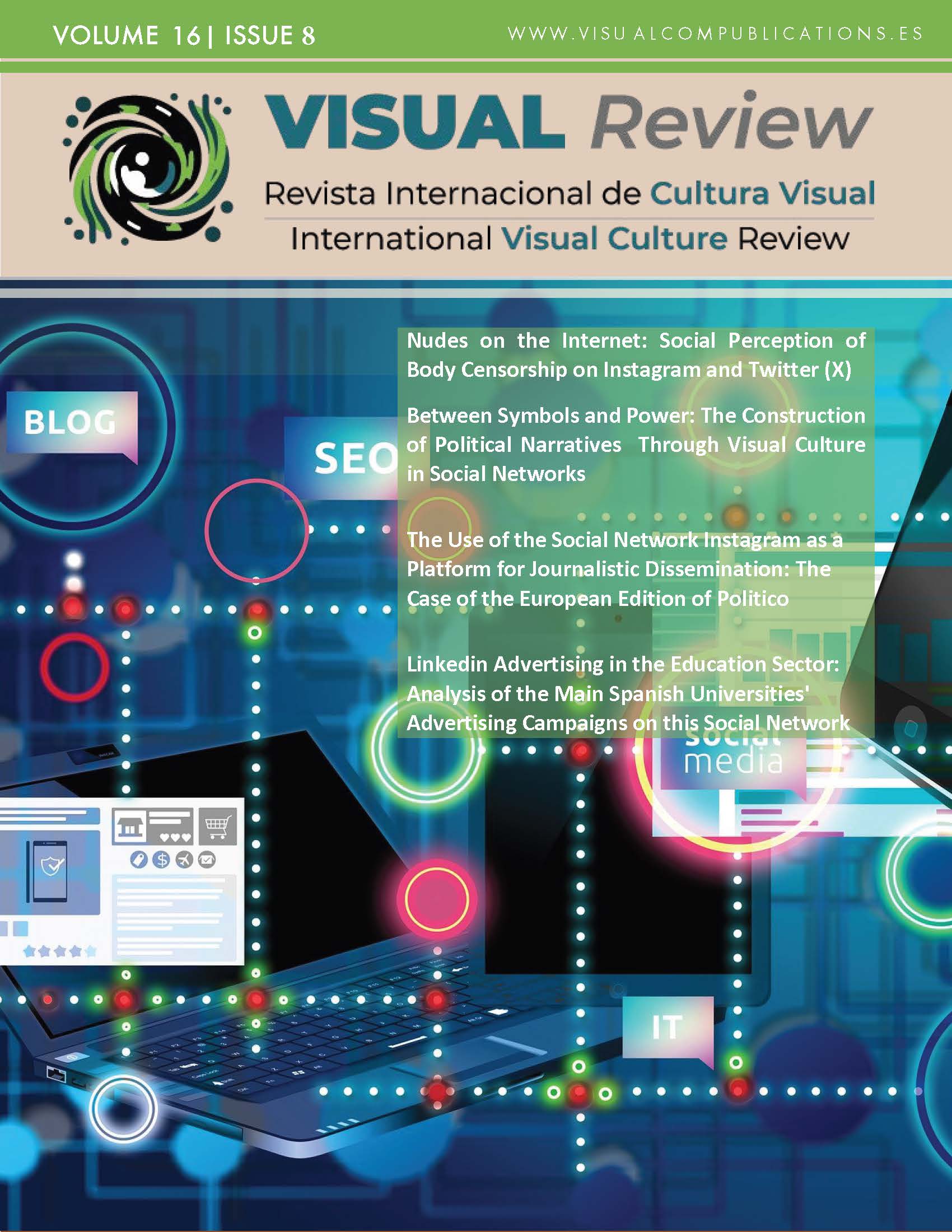Analysis of the Visual Depiction of Homosexuality in Spanish Cinematic Narratives between 1970 & 1979
DOI:
https://doi.org/10.62161/revvisual.v16.5311Keywords:
Spanish cinema, Spanish transition, Homosexuality, Late Francoism, Film characterAbstract
This research examines the portrayal of both male and female homosexuality in Spanish cinema between the years 1970 and 1979. In order to achieve this objective, a sample of 575 feature films produced and released over the course of the decade was selected, and a total of 74 films were chosen from this sample. The recurrence of films containing representations of both male and female homosexuality during the five years preceding and following the conclusion of the dictatorship is examined. From the perspective of narrative theory, a quantitative character analysis is conducted to ascertain traits pertaining to age, educational level, openness, family integration, socio-economic status, and personal care of the identified profiles. This analysis reveals the emergence of distinct typologies in late-Francoist cinema that diverge from those observed in the narratives produced during the early years of the Transition, particularly regarding the portrayal of both male and female homosexuality.
Downloads
Global Statistics ℹ️
|
305
Views
|
132
Downloads
|
|
437
Total
|
|
References
Alfeo, J. C. (2003). El personaje homosexual masculino como protagonista en la cinematografía española. [Tesis doctoral, Universidad Complutense de Madrid]. Tesis electrónica y repositorio. T21969. https://hdl.handle.net/20.500.14352/54923
Álvarez Junco, J. (2022). Qué hacer con un pasado sucio. Galaxia Guttenberg.
American Psychological Association. (2008, October 29). Understanding sexual orientation and homosexuality. APA. https://www.apa.org/topics/lgbtq/orientation
Brady, A. y Schirato, T. (2010). Understanding Judith Butler. Sage Publications.
Chatman, S. (1990). Historia y discurso. Taurus.
Codesido, V., García, F. G., & García, M. L. (2022). Representación de Madrid y Barcelona en los discursos fílmicos de la Transición española. Visual Review, Revista Internacional de Cultura Visual. https://doi.org/10.37467/gkarevvisual.v9.3192
Codesido, V. (2022). El discurso cinematográfico español en la década de los 70: análisis narrativo del tardofranquismo a la Transición. [Tesis doctoral, Universidad Complutense de Madrid]. Tesis electrónica y repositorio. https://hdl.handle.net/20.500.14352/3976
Deutsch, H. (1933). Female sexuality. The International Journal of Psycho-Analysis. https://doi.org/10.1177/070674378903400906
Durand, G. (2005). Las estructuras antropológicas de lo imaginario. Taurus.
Europa Press Sociedad. (2023, 1 junio). España es el segundo país del mundo con mayor porcentaje de población LGTBI+, un 14%, según un estudio. Europa Press. https://www.europapress.es/sociedad/noticia-espana-segundo-pais-mundo-mayor-porcentaje-poblacion-lgtbi-14-estudio-20230601125355.html
Fassler, Barbara. (1979). Theories of Homosexuality as Sources of Bloomsbury’s Androgyny. Signs: Journal of Women in Culture and Society. http://dx.doi.org/10.5539/ijps.v5n2p32
Garay, B. G., & Álvarez, J. C. A. (2017). Formas de representación de la homosexualidad en el cine y la televisión españoles durante el franquismo. L'Atalante. Revista de estudios cinematográficos. https://revistaatalante.com/index.php/atalante/article/view/386
García García, F. (22-26, novembre de 1999). Narrativa audiovisual y nuevas tecnologías. La Hipernarrativa. En X. López García & X. Soengas Pérez, Comunicar no século XXI, (pp. 43-57). Actas do Congreso, Santiago de Compostela. http://hdl.handle.net/10347/12150
Gómez, H. C. G., & Gómez, I. (2023). La «herencia patológica»: modelos de representación del cuerpo homosexual en el cine LGTBI+ español. Revista Prisma Social. https://revistaprismasocial.es/article/view/4937
Hall, S. (1997). El trabajo de la representación. En Stuart Hall (Ed). Representation: Cultural Representations and Signifying Practices (pp. 13-74). Sage Publications. https://archive.org/stream/pdfy_chKTwaEs_TTEn9/14_El_trabajo_de_la_representacion_Stuart_Hall_djvu.txt
Hartson, M. T. (2015). Voracious Vampires and other Monsters: Masculinity and the Terror genre in Spanish Cinema of the Transición. Romance Notes. https://doi.org/10.1353/rmc.2015.0010.
Hjelmslev, Louis (1974). Prologómenos a una teoría del lenguaje. Gredos.
Hopewell, J. (1989). El cine español después de Franco 1973-1988. El Arquero.
Huerta, M. A. (2012). El "cine de barrio" tardofranquista: reflejo de una sociedad. Biblioteca Nueva.
Foucault, M. (1977). Historia de la Sexualidad l. La voluntad de saber. Siglo XXI.
Kaan, H. (2016). Psychopathia Sexualis. Cornell University Press.
Kinsey, A. C., Pomeroy, W. R., & Martin, C. E. (2003). Sexual behavior in the human male. 1948. American journal of public health. https://doi.org/10.2105/ajph.93.6.894
Likert, R. (1932). A technique for the measurement of attitudes. Archives of psychology. https://legacy.voteview.com/pdf/Likert_1932.pdf
Lomas, S. (2022). Creadores queer en el cine español del franquismo. Laertes.
Martínez, R.. (2019). Cine y forma: fundamentos para conjeturar la visualidad fílmica. Universidad Autónoma Metropolitana.
Melero , A. (2010). Placeres ocultos. Gays y lesbianas en el cine español de la Transición. Notorious.
Melero, A. (2014). La representación de la homosexualidad en el cine de la dictadura franquista. Zer. https://doi.org/10.1387/zer.13500
Mitchell, W. T. (2009). Teoría de la imagen. Ediciones Akal.
Mirzoeff, N. (2016). El derecho a mirar. IC-Revista Científica de Información y Comunicación. http://dx.doi.org/10.12795/IC.2016.i01.01
Monterde, J. E. (1993). Veinte años de cine español (1973-1992). Un cine bajo la paradoja. Paidós.
Pérez, J. P. (2016). Metodología de análisis del personaje cinematográfico: Una propuesta desde la narrativa fílmica. Razón y palabra. https://revistarazonypalabra.org/index.php/ryp/article/view/685
Rancière, J. (2005). La fábula cinematográfica: reflexiones sobre la ficción en el cine. Grupo Planeta.
Rocha, S. M. (2018). Visualidad política latinoamericana en Narcos: un análisis a través del estilo televisivo. Comunicación y Medios. https://doi.org/10.5354/0719-1529.2018.48572
Rosenstone, R. (2013). Cine y visualidad. Historización de la imagen contemporánea. Finis Terrae.
Sánchez-Labella, I. (2016). ¿Cómo abordar la construcción de los personajes creados para ficción? Una herramienta para el análisis desde una perspectiva narrativa y de género. En M. Oller y M. C. Tornay (Eds). Comunicación, periodismo y género. Una mirada desde Iberoamérica (pp. 267-277). Egregius.
Stock, K. (2019). XIV Sexual Orientation: What Is It? Proceedings of the Aristotelian Society. https://doi.org/10.1093/arisoc/aoz01
Westphal, C. (1870). Die conträre Sexualempfindung, Symptom eines neuropathischen en (psychopathischen Zustandes). Archiv für Psychiatrie und Nervenkrankhei
Downloads
Published
How to Cite
Issue
Section
License
Copyright (c) 2024 VISUAL REVIEW. International Visual Culture Review / Revista Internacional de Cultura Visual

This work is licensed under a Creative Commons Attribution-NoDerivatives 4.0 International License.
Those authors who publish in this journal accept the following terms:
-
Authors retain copyright.
-
Authors transfer to the journal the right of first publication. The journal also owns the publishing rights.
-
All published contents are governed by an Attribution-NoDerivatives 4.0 International License.
Access the informative version and legal text of the license. By virtue of this, third parties are allowed to use what is published as long as they mention the authorship of the work and the first publication in this journal. If you transform the material, you may not distribute the modified work. -
Authors may make other independent and additional contractual arrangements for non-exclusive distribution of the version of the article published in this journal (e.g., inclusion in an institutional repository or publication in a book) as long as they clearly indicate that the work was first published in this journal.
- Authors are allowed and recommended to publish their work on the Internet (for example on institutional and personal websites), following the publication of, and referencing the journal, as this could lead to constructive exchanges and a more extensive and quick circulation of published works (see The Effect of Open Access).













